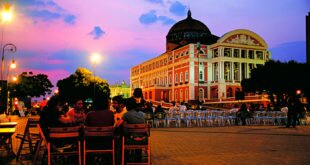The Manaus Free Trade Zone (ZFM) was envisioned by Federal Congressman Francisco Pereira da Silva and created by Law No. 3,173 of June 6, 1957, as a Free Port.
What is the Manaus Free Trade Zone Project?
The Manaus Free Trade Zone (MFTZ) is an economic development model implemented by the Brazilian government with the objective of creating an economic base in Western Amazonia, promoting better productive and social integration of this region with the country, and guaranteeing national sovereignty over its borders.
The most successful regional development strategy, the model brings to the region it covers (Western Amazon states: Acre, Amazonas, Rondonia, and Roraima, and the cities of Macapá and Santana in Amapá) economic development allied with environmental protection, providing a better quality of life for its population.
The MFTz comprises three economic poles: commercial, industrial, and agricultural. The first had its greatest growth until the end of the 1980s, when Brazil adopted the closed economy regime. The industrial one is considered the basis of the MFTz. The Manaus Industrial Complex has approximately 600 high-tech industries, generating more than half a million jobs, direct and indirect, mainly in the electro-electronic, two-wheel, and chemical segments. Among the products manufactured are: cell phones, audio and video devices, televisions, motorcycles, and concentrates for soft drinks, among others. The Agribusiness pole houses projects focused on food production activities, agribusiness, fish farming, tourism, wood processing, among others.
Manaus Industrial Complex still under construction (Divulgação/Arquivo ACA)
History
The Manaus Free Trade Zone (MFTZ) was idealized by Federal Congressman Francisco Pereira da Silva and created by Law No. 3173 of June 6, 1957as a Free Port.
Ten years later, the Federal Government, through Decree-Law Nº 288of February 28, 1967, expanded this legislation and reformulated the model, establishing fiscal incentives for 30 years for the implementation of an industrial, commercial and agricultural center in the Amazon. Thus, the current development model was instituted, which encompasses a physical area of 10 thousand km², with the city of Manaus as its center, and is based on Fiscal and Extrafiscal Incentives, instituted with the objective of reducing locational disadvantages and providing conditions for leveraging the development process of the incentivized area.
In 1967, through Decree-Law nº 291 the Federal Government defined Western Amazon as it is known, comprising the states of Amazonas, Acre, Rondônia and Roraima. The measure aimed to promote the occupation of this region and raise the level of security for the maintenance of its integrity. A year later, on August 15, 1968, through Decree-Law No. 356/68the Federal Government extended part of the benefits of the MFTz model to the entire Western Amazon.
Since 1989, the Superintendence of the Manaus Free Trade Zone (SUFRAMA), which manages the model, has had seven Free Trade Areas (FTAs) within its area of jurisdiction, created with the goal of promoting the development of municipalities that are international borders in the Amazon and integrating them with the rest of the country, by extending some of the tax benefits of the MFTZ model, improving the supervision of the entry and exit of goods, and strengthening the commercial, agribusiness, and extractive sectors. The first to be created was Tabatinga, in Amazonas, through the Law nº 7.965/89. In the following years, the cities of Macapá-Santana were created (Law 8,387/91, article II), in Amapá; Guajará-Mirim (Law 8,210/91), in Rondônia; Cruzeiro do Sul and Brasiléia-Epitaciolândia (Law 8,857/94), in Acre; and Bonfim and Boa Vista (Provisional Measure 418/08), in Roraima.
The history of the MFTZ model can be configured in four distinct phases until it reaches the current phase.
Moto Honda Company in the 1970s, at the Manaus Industrial Complex (Divulgação/Arquivo ACA)
The first phase
From 1967 to 1975, the industrial policy of reference in the country was characterized by the stimulus to import substitution of final goods and the formation of a domestic market.
In this phase, the MFTZ model had as relevant aspects
-
the predominance of commercial activities (no import limitations, except for weapons and ammunition, tobacco, alcoholic beverages, passenger cars and perfumes);
-
a large domestic tourist flow, stimulated by the sale of products whose importation was prohibited in the rest of the country;
-
expansion of the tertiary sector; and
-
start of industrial activity, with activity based on CKD - Completely Knocked Down Completely Knocked Down and SKD - Semi Knocked Down Semi Knocked Down (fully or semi-knocked down products) and with freedom to import inputs. The laying of the cornerstone of the Industrial District occurred on September 30, 1968.
SUFRAMA, for its part, had as its main institutional characteristics, the control of entry and storage of goods, with predominance of the customs function and a focus on Manaus.
The second phase
This period lasted from 1975 to 1990. In this phase, the industrial policy of reference in the country was characterized by the adoption of measures to promote the domestic input industry, especially in the state of São Paulo.
The MFTZ model came to have the following characteristics:
-
with the edition of the Decree-Laws Nº 1435/75 e 1455/76Minimum Nationalization Indexes were established for products manufactured in the MFTz and sold in other locations in Brazil;
-
Global annual import ceilings were also established (contingency);
-
The assembly industry in Manaus grows, also contributing to the development of a domestic industry of components and inputs. In 1990, the industry in Manaus registered one of its best performances, with the generation of 80 thousand direct jobs and billing of US$ 8.4 billion;
-
Trade remains as a dynamic vector;
-
The incentives of the MFTz model are extended to the Western Amazon;
-
the first of seven Free Trade Areas (FTAs) is created, in Tabatinga, Amazonas, according to Law No. 7,965/89;
-
The validity of the ZFM model is extended for the first time, from 1997 to 2007, through Decree No. 92,560, of April 16, 1986. In 1998, through Article 40 of the Transitory Provisions Act of the Federal Constitution, the deadline was extended to 2013.
SUFRAMA began to operate with the management of incentives and control of industrial projects and expanded its actions to the states of the Western Amazon, with the implementation of decentralized units and FTAs.
The third phase
This phase spanned the years 1991 to 1996. In this phase, the New Industrial and Foreign Trade Policy came into effect, marked by the opening of the Brazilian economy, import tax reduction for the rest of the country, and emphasis on quality and productivity, with the implementation of the Brazilian Quality and Productivity Program (PBPQ) and the Industrial Competitiveness Program. The edition of Law 8.387 of December 30, 1991, established deep changes in the MFTz model.
The MFTZ model was forced to adapt to the new industrial policy of reference in the country, experiencing the following characteristics:
-
loss of trade relevance, which no longer had the exclusivity of imports as a comparative advantage;
-
elimination of the annual global import ceilings, by means of Decree No. 205of September 5, 1991;
-
adoption of an 88% import tax reducer for ZFM, with the enactment of Law 8,387 of December 30, 1991;
-
adoption of the Basic Productive Process (PPB), replacing the Minimum Nationalization Index;
-
Law 8,387/91 also established that industries producing goods and computer services, in order to qualify for incentives under the MFTz model, must annually invest at least 5% of their gross revenues in research and development activities to be carried out in the Amazon;
-
Through Decree No. 783 of March 25, 1993, the industries were required to implement technical quality standards, according to the standards of entities accredited by the National Institute of Metrology, Standardization and Industrial Quality (INMETRO);
-
The companies in the Industrial Pole of Manaus began a broad process of industrial modernization, with emphasis on automation, quality and productivity; In 1996, the restructuring of the industrial park reflected in record sales for that decade, on the order of US$ 13.2 billion.
-
The Macapá-Santana Free Trade Area was created in Amapá, the only municipalities in Eastern Amazonia to fall under SUFRAMA's jurisdiction.
SUFRAMA adopted, during this phase, the orientative corporate planning and began to act in the management of the Basic Productive Processes (PPBs), in the attraction and promotion of investments and in the development of actions capable of irradiating the positive effects of the Manaus Industrial Pole, with the intensification of investments throughout its area of jurisdiction. In this phase, the Autarchy becomes the federal political arm in the region.
The fourth phase
Comprises the period from 1996 to 2002, in which the industrial policy of reference in the country was characterized by its adaptation to the scenarios of a globalized economy and the adjustments demanded by the effects of the Real Plan, such as the privatization and deregulation movement.
In this phase, the main characteristics of the MFTZ model were
-
The inclusion of the export function as an intentional policy, aiming to stimulate foreign sales from the Manaus Industrial Pole, which went from a little over US$ 140 million in 1996 to US$ 2 billion in 2005;
-
Exhaustion of the FTAs as instruments of internalization of the MFTz model. In the molds in which they were created, with incentives for imports, they lost relevance with the opening of the country's economy;
-
Establishment of criteria for the transfer of financial resources from SUFRAMA for the promotion of regional development, by means of Resolution No. 052, of August 1, 1997making distribution more equitable.
-
Search for the expansion of technological competitiveness of Manaus industries, which had as its initial milestone the creation of the Center for Science, Technology and Innovation of the Industrial Pole of Manaus (CT-PIM);
-
Initiatives for the creation of a pole of bio-industries in the Amazon that culminated with the implantation of the Biotechnology Center of the Amazon, inaugurated in 2002.
SUFRAMA began to operate, in this phase, as a regional instance of national industrial policies and as an articulator and mediator of regional interests. In this period, the autarchy consolidates its strategic planning, improves its control systems, includes the technological function in its strategies, and holds the first International Fair of the Amazon, as a tool to promote the competitive international insertion of the model.
Current Phase
The Productive Development Policy (PDP) comes into effect as a deepening of the Industrial, Technological and Foreign Trade Policy (PITCE), which foresees greater production efficiency and innovation capacity for companies and export expansion. The PDP defines macro-targets for the country until 2010, which foresee the increase in the gross formation of fixed capital, greater spending of the private sector in research and development (R&D), and the expansion of Brazilian exports, especially by micro and small enterprises.
In 2006, a presidential decree regulated the new IT Law, which extended tax incentives for the sector throughout the country from 2009 to 2019. O Decree 5,906of September 26, 2006, regulated articles of Law 11,077of December 30, 2004, of Law No. 8248 of October 23, 1991 (which provide for the qualification and competitiveness of the computer and automation sector), and of Law No. 10,176 of October 23, 1991 (which provides for the qualification and competitiveness of the computer and automation sector). Law No. 10.176of January 11, 2001, (the latter provides for the qualification and competitiveness of the information technology sector).
The Brazilian Digital TV System, a digital transmission standard based on the Japanese system ISDB-T (Integrated Service for Digital Terrestrial Transmission), comes into operation in 2007. This new scenario enhances the digital convergence process in the country.
Also concentrated in this phase is the strategic implementation of the Basic Productive Process (PPB) of biocosmetics, establishing the shares in local added value and minimum quantities of use of regional inputs, through the Interministerial Ordinance No. 842, December 27, 2007.
Current characteristics of the Manaus Free Trade Zone model:
-
The term of validity of the model was extended from 2013 to 2023, through the Constitutional Amendment No. 42of December 19, 2003;
-
The definition of Basic Productive Processes (PPBs) for products manufactured in the PIM is guided by the greater densification of national production chains, including biocosmetics;
-
There is an effort to expand the model's international insertion, especially through commercial missions, participation in foreign trade agreements, and holding commercial promotion events, such as the Amazon International Fair;
-
The search for increased exports and a better balance of trade remains;
-
There is an effort by the industries of the PIM to promote the technological densification of the industrial park, through investments in regional research institutes, especially from resources of the percentage allocated to Research and Development (R&D), determined by the Information Technology Law in force;
-
SUFRAMA has expanded its investments in projects to modernize production and infrastructure in the municipalities in its area of activity, involving the construction of airports, roads, tourist structures, pilot production projects and labor training.
Suframa, in the current phase, consolidates the review process of its strategic planning, in which it better configures the performance of its function as a regional development agency. At the same time, it is incrementing projects for the strengthening of the PIM and for the improvement of regional potentialities, especially through the Center of Science, Technology and Innovation of the Industrial Pole of Manaus (CT-PIM) and the Center of Biotechnology of the Amazon (CBA).
The autarchy also works on the deepening and improvement of the function of promotion and supervision of finalistic projects (Industrial, Agricultural, etc.); institutionalization of the function of development agency (execution of studies, promotion of intermediate projects, infrastructure, R&D, etc.); expansion and integration of activities of technological prospection, commercial intelligence and strategic planning, and expansion of activities of studies and research on public policies and socioeconomic development in the Western Amazon.
It develops actions to strengthen the regional system of Science, Technology and Innovation, through the application of resources in teaching and R&D structures, training of post-graduated human resources, and technical and scientific cooperation agreements with national and international institutions. It also supports the economic cooperation and integration of the Pan-Amazon.
 Agile Manaus tourism and culture of Amazonas
Agile Manaus tourism and culture of Amazonas



